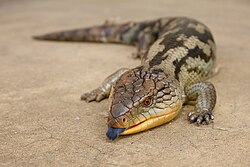| Blue-tongued skinks | |
|---|---|
 | |
| Blotched blue-tongued skink (Tiliqua nigrolutea) | |
| Scientific classification | |
| Kingdom: | Animalia |
| Phylum: | Chordata |
| Class: | Reptilia |
| Order: | Squamata |
| Family: | Scincidae |
| Subfamily: | Egerniinae |
| Genus: | Tiliqua Gray, 1825 [1] |
| Species | |
Eight extant, see text. | |
| Synonyms | |
Trachydosaurus | |
Blue-tongued skinks [2] comprise the Australasian genus Tiliqua, which contains some of the largest members of the skink family (Scincidae). They are commonly called blue-tongued lizards or simply blue-tongues or blueys in Australia or panana in Indonesia. As suggested by these common names, a prominent characteristic of the genus is a large blue tongue that can be bared as bluff-warning to potential enemies. [3] Their tongue can also deform itself and produce a thick mucus in order to catch prey. [4] They are relatively shy in comparison with other lizards, and also significantly slower due to their shorter legs.








